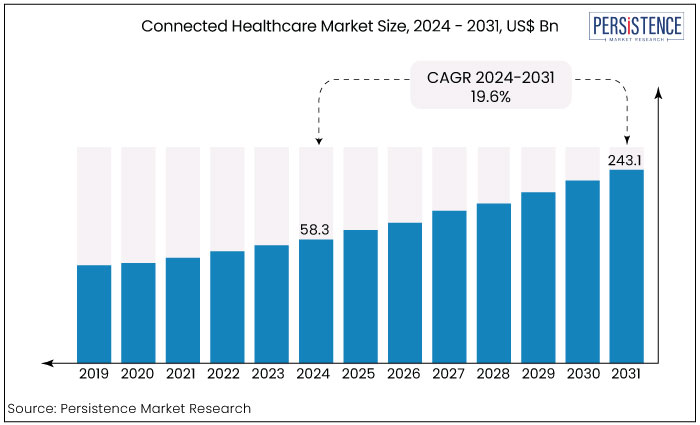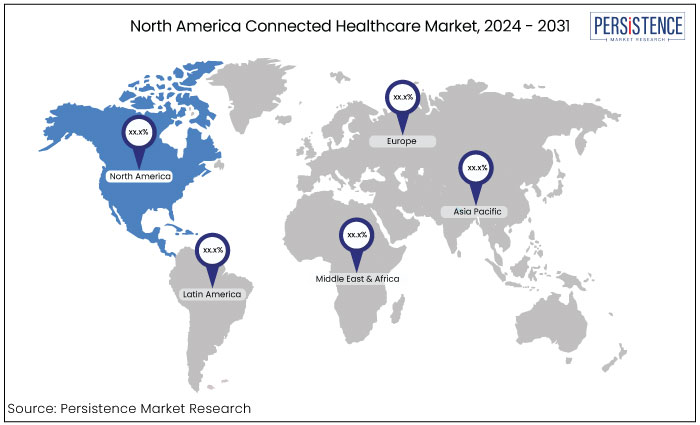Industry: Healthcare
Published Date: September-2024
Format: PPT*, PDF, EXCEL
Delivery Timelines: Contact Sales
Number of Pages: 160
Report ID: PMRREP34818
The connected healthcare market is estimated to increase from US$58.3 Bn in 2024 to 243.1 Bn by 2031. The market is projected to record a CAGR of 19.6% during the forecast period from 2024 to 2031. Market expansion is attributed to the emerging trends such as telehealth, wearable devices, AI and ML integration, and blockchain technology. AI and ML are revolutionizing data analytics, while blockchain enhances data security. The growing emphasis on preventive care and wellness management is making the market attractive for startups and established players.

Key Highlights of the Market
|
Market Attributes |
Key Insights |
|
Connected Healthcare Market Size (2024E) |
US$58.3 Bn |
|
Projected Market Value (2031F) |
US$243.1 Bn |
|
Global Market Growth Rate (CAGR 2024 to 2031) |
19.6% |
|
Historical Market Growth Rate (CAGR 2019 to 2023) |
16.36% |
Connected healthcare solutions can help reduce costs by improving efficiency and enabling remote patient monitoring. Patients increasingly prefer personalized and accessible healthcare services, fueling the demand for connected health technologies.
The region led the global market in 2020, driven by escalating healthcare costs, widespread smartphone adoption, and increased demand for connected healthcare solutions particularly remote patient monitoring.

Europe holds the second-largest position in the market and is expected to grow further primarily driven by the substantial rise in smartphone usage among both consumers and healthcare professionals. This trend is further fueled by the growing adoption of remote patient monitoring services, which enable tracking various health conditions from afar.
A notable development occurred in 2020 when Germany's Digital Healthcare Act (DVG) permitted physicians to prescribe medications via mobile applications, as reported by Healthcare IT News.
The mHealth services segment is predicted to become dominant in the market in 2024 primarily driven by the rising adoption of smartphones and mobile health applications.
According to the State of Mobile Internet Connectivity Report 2020, approximately 3.8 billion people were utilizing mobile internet by the end of 2019, reflecting a significant increase of 250 million users from 2018. The proliferation of smartphones enables great access to healthcare services via wireless technology, thereby boosting mHealth service adoption.
The global connected healthcare market is segmented into various categories, including diagnosis and treatment, monitoring applications, wellness and prevention, and healthcare management.
In 2024, the wellness and prevention segment is expected to emerge as the market leader and to grow rapidly in the coming years. This growth is attributed to the increasing integration of health technology into social care and wellness initiatives.
The connected healthcare market overview shows that the industry has great potential, and trends are fueling the growth in the upcoming years. Connected healthcare refers to the integration of technology into healthcare services enabling real-time communication and data exchange between patients, healthcare providers, and medical devices.
The industry is witnessing significant growth driven by several emerging trends. One of the most prominent market trends is the increasing adoption of telehealth solutions particularly accelerated by the COVID-19 pandemic, which has normalized virtual consultations.
The rise of wearable devices such as smartwatches and fitness trackers is empowering patients to take charge of their health by monitoring vital signs and activity levels. The integration of artificial intelligence (AI) and machine learning (ML) into connected healthcare systems is revolutionizing data analytics.
The use of blockchain technology in managing EHRs is also gaining traction as it enhances data security and interoperability. Furthermore, the increasing emphasis on preventive care and wellness management is driving investments in connected healthcare solutions making the market increasingly attractive for both startups and established players.
The connected healthcare market analysis has shown remarkable growth over 2019 to 2023, driven by advancements in technology and a growing demand for more efficient healthcare solutions. Initially, the market was primarily focused on telemedicine and basic electronic health records (EHRs).
As digital health technologies evolved, the scope expanded to include a wide array of connected devices, mobile health applications, and data analytics platforms. This evolution has been fueled by the increasing prevalence of chronic diseases, the aging population, and the need for improved patient engagement and outcomes.
Telehealth services surged as healthcare providers aimed to maintain continuity of care while minimizing the risk of virus transmission. Investments in digital health have skyrocketed in recent years with significant funding directed toward innovative startups and established companies while creating several connected healthcare market opportunities for growth.
The course for the market appears promising. The industry is expected to reach 19.6% of CAGR during forecast period. The integration of artificial intelligence (AI) and machine learning (ML) is expected to transform the landscape further enabling more personalized and predictive healthcare solutions. As healthcare systems increasingly prioritize data-driven decision-making, the demand for advanced analytics and interoperability will continue to grow.
Increasing Demand for Telehealth Services
The surge in demand for telehealth services has been a significant growth driver for the connected healthcare market demand. The COVID-19 pandemic accelerated the adoption of virtual consultations, allowing patients to access healthcare from the comfort of their homes.
This shift not only improved patient convenience but also expanded access to care for those in remote or underserved areas. As healthcare providers continue to integrate telehealth into their services, the market is expected to grow further, driven by ongoing consumer preference for remote healthcare solutions.
Advancements in Wearable Technology
The rapid advancements in wearable technology have significantly contributed to the connected healthcare market growth. Devices such as smartwatches and fitness trackers enable continuous monitoring of vital signs and health metrics empowering individuals to take charge of their health.
Wearables facilitate real-time data collection, which can be shared with healthcare providers for better management of chronic conditions. As technology continues to evolve, the integration of more sophisticated features in wearables will likely to drive further adoption and innovation in connected healthcare solutions.
Focus on Preventive Healthcare
The increasing emphasis on preventive healthcare is another key driver propelling the connected healthcare market expansion. With rising healthcare costs and a growing awareness of the importance of early intervention, both patients and providers are prioritizing preventive measures.
Connected healthcare technologies such as remote monitoring and health management apps enable proactive health management by providing timely insights and alerts. This shift toward prevention not only enhances patient outcomes but also reduces the overall burden on healthcare systems making connected healthcare solutions more appealing to stakeholders across the industry.
Data Privacy and Security Concerns
One of the primary factors impeding the connected healthcare market growth is the increasing concern over data privacy and security. As healthcare systems become more interconnected, the risk of data breaches and unauthorized access to sensitive patient information rises significantly.
Patients and healthcare providers alike are wary of sharing personal health data due to fears of identity theft and misuse. This apprehension can hinder the adoption of connected healthcare technologies, as stakeholders may be reluctant to implement solutions that do not adequately address these critical security concerns.
Regulatory Challenges and Compliance Issues
Regulatory challenges and compliance issues present another significant barrier to the connected healthcare market growth. The healthcare industry is subject to stringent regulations regarding data management, patient privacy, and technology integration.
Navigating these complex regulatory frameworks can be daunting for healthcare providers and technology developers, often leading to delays in the deployment of connected solutions. Additionally, strict regulations across different regions can create clarity and consistency, further impeding the market's growth as organizations struggle to meet varying compliance requirements.
Integration of AI and ML
The integration of artificial intelligence (AI) and machine learning (ML) into connected healthcare systems presents a significant future opportunity. These technologies can enhance data analytics by providing predictive insights and personalized treatment plans improving patient outcomes.
AI-driven tools can analyze vast amounts of health data to identify patterns and trends, enabling proactive interventions. As healthcare providers increasingly adopt AI and ML solutions, more connected healthcare market opportunities for innovative applications, such as automated diagnosis and personalized medicine will drive growth in the connected healthcare landscape.
Rise of Remote Patient Monitoring Solutions
Expanding remote patient monitoring (RPM) solutions is another promising opportunity for expanding the connected healthcare market. With the increasing prevalence of chronic diseases and an aging population, healthcare providers are increasingly seeking ways to monitor patients outside traditional clinical settings.
RPM technologies including wearable devices and mobile health apps allow continuous health tracking and timely interventions. This trend empowers patients to manage their health effectively and alleviates pressure on healthcare systems. As the demand for RPM solutions rises, significant growth in this sector is anticipated.
The connected healthcare market is characterized by intense competition among key players innovating to enhance patient care. For instance, Philips has launched several innovative products since 2022 including the Philips HealthSuite, a cloud-based platform that integrates data from various health devices to provide personalized health insights. These advancements reflect a broader trend of leveraging technology to improve patient outcomes and streamline healthcare delivery. Consequently, positioning these companies as leaders in the evolving connected healthcare landscape.
Recent Developments in the Connected Healthcare Market
|
Attributes |
Details |
|
Forecast Period |
2024 to 2031 |
|
Historical Data Available for |
2019 to 2023 |
|
Market Analysis |
US$ Billion for Value |
|
Key Regions Covered |
|
|
Key Market Segments Covered |
|
|
Key Companies Profiled |
|
|
Report Coverage |
|
|
Customization & Pricing |
Available upon request |
By Type
By Application
By Region
To know more about delivery timeline for this report Contact Sales

The market is predicted to rise from US$58.3 Bn in 2024 to US$243.1 Bn by 2031.
A few of the key manufactures in the market are Agamatrix, AirStrip Technologies, and AliveCor Inc.
The mHealth services is leading segment and is expected to dominate the market in 2024.
North America is leading region in the market.
The integration of AI and machine learning provides a key opportunity for the market players.